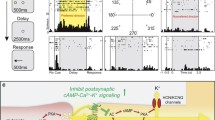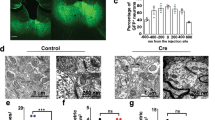Abstract
Cognitive disorders such as schizophrenia and Alzheimer’s disease are associated with dysfunction of the highly evolved dorsolateral prefrontal cortex (dlPFC), and with changes in glutamatergic N-methyl-D-aspartate receptors (NMDARs). Recent research on the primate dlPFC discovered that the pyramidal cell circuits that generate the persistent firing underlying spatial working memory communicate through synapses on spines containing NMDARs with NR2B subunits (GluN2B) in the post-synaptic density. This contrasts with synapses in the hippocampus and primary visual cortex, where GluN2B receptors are both synaptic and extrasynaptic. Blockade of GluN2B in the dlPFC markedly reduces the persistent firing of the Delay cells needed for neuronal representations of visual space. Cholinergic stimulation of nicotinic α7 receptors within the glutamate synapse is necessary for NMDAR actions. In contrast, α-amino-3-hydroxy-5-methyl-4-isoxazolepropionic acid receptors have only subtle effects on the persistent firing of Delay cells, but contribute substantially to the firing of Cue and Response cells. Systemic administration of the NMDAR antagonist ketamine reduces the persistent firing of Delay cells, but increases the firing of some Response cells. The reduction in persistent firing produced by ketamine may explain why this drug can mimic or worsen the cognitive symptoms of schizophrenia. Similar actions in the medial PFC circuits representing the emotional aspects of pain may contribute to the rapid analgesic and anti-depressant actions of ketamine.
Similar content being viewed by others
References
Dingledine R, Borges K, Bowie D, Traynelis SF. The glutamate receptor ion channels. Pharmacol Rev 1999, 51: 7–61.
Erreger K, Dravid SM, Banke TG, Wyllie DJ, Traynelis SF. Subunit-specific gating controls rat NR1/NR2A and NR1/NR2B NMDA channel kinetics and synaptic signalling profiles. J Physiol 2005, 563: 345–358.
Kristiansen LV, Bakir B, Haroutunian V, Meador-Woodruff JH. Expression of the NR2B-NMDA receptor trafficking complex in prefrontal cortex from a group of elderly patients with schizophrenia. Schizophr Res 2010, 119: 198–209.
Kurup P, Zhang Y, Xu J, Venkitaramani DV, Haroutunian V, Greengard P, et al. Abeta-mediated NMDA receptor endocytosis in Alzheimer’s disease involves ubiquitination of the tyrosine phosphatase STEP61. J Neurosci 2010, 30: 5948–5957.
Preuss T. Do rats have prefrontal cortex? The Rose-Woolsey-Akert program reconsidered. J Cognit Neurosci 1995, 7: 1–26.
Goldman-Rakic PS. Working memory dysfunction in schizophrenia. J Neuropsychiatry Clin Neurosci 1994, 6: 348–357.
Lim HK, Juh R, Pae CU, Lee BT, Yoo SS, Ryu SH, et al. Altered verbal working memory process in patients with Alzheimer’s disease: an fMRI investigation. Neuropsychobiology 2008, 57: 181–187.
Liu L, Wong TP, Pozza MF, Lingenhoehl K, Wang Y, Sheng M, et al. Role of NMDA receptor subtypes in governing the direction of hippocampal synaptic plasticity. Science 2004, 304: 1021–1024.
Cho KK, Khibnik L, Philpot BD, Bear MF. The ratio of NR2A/B NMDA receptor subunits determines the qualities of ocular dominance plasticity in visual cortex. Proc Natl Acad Sci U S A 2009, 106: 5377–5382.
Lüscher C, Malenka RC. NMDA receptor-dependent longterm potentiation and long-term depression (LTP/LTD). Cold Spring Harb Perspect Biol 2012, 4:pii: a005710.
Yuste R, Bonhoeffer T. Morphological changes in dendritic spines associated with long-term synaptic plasticity. Annu Rev Neurosci 2001, 24: 1071–1089.
Tashiro A, Yuste R. Regulation of dendritic spine motility and stability by Rac1 and Rho kinase: evidence for two forms of spine motility. Mol Cell Neurosci 2004, 26: 429–440.
Araya R, Jiang J, Eisenthal KB, Yuste R. The spine neck filters membrane potentials. Proc Natl Acad Sci U S A 2006, 103: 17961–17966.
Goebel-Goody SM, Davies KD, Alvestad Linger RM, Freund RK, Browning MD. Phospho-regulation of synaptic and extrasynaptic N-methyl-d-aspartate receptors in adult hippocampal slices. Neuroscience 2009, 158: 1446–1459.
Baez MV, Oberholzer MV, Cercato MC, Snitcofsky M, Aguirre AI, Jerusalinsky DA. NMDA receptor subunits in the adult rat hippocampus undergo similar changes after 5 minutes in an open field and after LTP induction. PLoS One 2013, 8: e55244.
Shipton OA, Paulsen O. GluN2A and GluN2B subunit-containing NMDA receptors in hippocampal plasticity. Philos Trans R Soc Lond B Biol Sci 2013, 369: 20130163.
Dupuis JP, Ladépêche L, Seth H, Bard L, Varela J, Mikasova L, et al. Surface dynamics of GluN2B-NMDA receptors controls plasticity of maturing glutamate synapses. EMBO J 2014, 33: 842–861.
Liu XB, Murray KD, Jones EG. Switching of NMDA receptor 2A and 2B subunits at thalamic and cortical synapses during early postnatal development. J Neurosci 2004, 24: 8885–8895.
Philpot BD, Weisberg MP, Ramos MS, Sawtell NB, Tang YP, Tsien JZ, et al. Effect of transgenic overexpression of NR2B on NMDA receptor function and synaptic plasticity in visual cortex. Neuropharmacology 2001, 41: 762–770.
Goldman PS, Rosvold HE. Localization of function within the dorsolateral prefrontal cortex of the rhesus monkey. Exp Neurol 1970, 27: 291–304.
Funahashi S, Bruce CJ, Goldman-Rakic PS. Mnemonic coding of visual space in the monkey’s dorsolateral prefrontal cortex. J. Neurophysiology 1989, 61: 331–349.
Goldman-Rakic PS. The “psychic cell” of Ramón y Cajal. Prog Brain Res 2002, 136: 427–434.
Goldman-Rakic PS. Cellular basis of working memory. Neuron 1995, 14: 477–485.
Wang XJ. Synaptic basis of cortical persistent activity: the importance of NMDA receptors to working memory. J Neurosci 1999, 19: 9587–9603.
Wang XJ. Synaptic reverberation underlying mnemonic persistent activity. Trends in Neurosci 2001, 24: 455–463.
Wang H, Stradtman GGr, Wang XJ, Gao WJ. A specialized NMDA receptor function in layer 5 recurrent microcircuitry of the adult rat prefrontal cortex. Proc Natl Acad Sci U S A 2008, 105: 16791–16796.
Wang MJ, Yang Y, Wang CJ, Gamo NJ, Jin LE, Mazer JA, et al. NMDA receptors subserve working memory persistent neuronal firing In dorsolateral prefrontal cortex. Neuron 2013, 77: 736–749.
Yang Y, Paspalas CD, Jin LE, Picciotto MR, Arnsten AFT, Wang M. Nicotinic α7 receptors enhance NMDA cognitive circuits in dorsolateral prefrontal cortex. Proc Nat Acad Sci USA 2013, 110: 12078–83.
Arnsten AFT, Wang MJ, Paspalas CD. Neuromodulation of thought: Flexibilities and vulnerabilities in prefrontal cortical network synapses. Neuron 2012, 76: 223–239.
Snyder EM, Nong Y, Almeida CG, Paul S, Moran TH, Choi EY, et al. Regulation of NMDA receptor trafficking by amyloid-beta. Nat Neurosci 2005, 8: 1051–1058.
Javitt DC. Glutamatergic theories of schizophrenia. Isr J Psychiatry Relat Sci 2010, 47: 4–16.
Banerjee A, Macdonald ML, Borgmann-Winter KE, Hahn CG. Neuregulin 1-erbB4 pathway in schizophrenia: From genes to an interactome. Brain Res Bull 2010, 30: 132–139.
Martin LF, Freedman R. Schizophrenia and the alpha7 nicotinic acetylcholine receptor. Int Rev Neurobiol 2007, 78: 225–246.
Kristiansen LV, Patel SA, Haroutunian VH, Meador-Woodruff JH. Expression of the NR2B-NMDA receptor subunit and its Tbr-1/CINAP regulatory proteins in postmortem brain suggest altered receptor processing in schizophrenia. Synapse 2010, 64: 495–502.
Weickert CS, Fung SJ, Catts VS, Schofield PR, Allen KM, Moore LT, et al. Molecular evidence of N-methyl-D-aspartate receptor hypofunction in schizophrenia. Mol Psychiatry 2013, 18: 1185–1192.
Schizophrenia Working Group of the Psychiatric Genomics Consortium. Biological insights from 108 schizophrenia-associated genetic loci. Nature 2014, 511: 421–427.
Fromer M, Pocklington AJ, Kavanagh DH, Williams HJ, Dwyer S, Gormley P, et al. De novo mutations in schizophrenia implicate synaptic networks. Nature 2014, 506: 179–184.
Driesen NR, McCarthy G, Bhagwagar Z, Bloch MH, Calhoun VD, D’Souza DC, et al. The impact of NMDA receptor blockade on human working memory-related prefrontal function and connectivity. Neuropsychopharmacology 2013, 38: 2613–2622.
Anticevic A, Gancsos M, Murray JD, Repovs G, Driesen NR, Ennis DJ, et al. NMDA receptor function in large-scale anticorrelated neural systems with implications for cognition and schizophrenia. Proc Natl Acad Sci U S A 2012, 109: 16720–16725.
Driesen NR, Leung HC, Calhoun VD, Constable RT, Gueorguieva R, Hoffman R, et al. Impairment of working memory maintenance and response in schizophrenia: functional magnetic resonance imaging evidence. Biol Psychiatry 2008, 64: 1026–1034.
Jackson ME, Homayoun H, Moghaddam B. NMDA receptor hypofunction produces concomitant firing rate potentiation and burst activity reduction in the prefrontal cortex. Proc Natl Acad Sci U S A 2004, 101: 8467–8472.
Malhotra AK, Pinals DA, Adler CM, Elman I, Clifton A, Pickar D, et al. Ketamine-induced exacerbation of psychotic symptoms and cognitive impairment in neuroleptic-free schizophrenics. Neuropsychopharmacology 1997, 17: 141–150.
Berman RM, Cappiello A, Anand A, Oren DA, Heninger GR, Charney DS, et al. Antidepressant effects of ketamine in depressed patients. Biol Psychiatry 2000, 47: 351–354.
Zarate CAJ, Singh JB, Carlson PJ, Brutsche NE, Ameli R, Luckenbaugh DA, et al. A randomized trial of an N-methyl-Daspartate antagonist in treatment-resistant major depression. Arch Gen Psychiatry 2006, 63: 856–864.
Murrough JW, Iosifescu DV, Chang LC, Al Jurdi RK, Green CE, Perez AM, et al. Antidepressant efficacy of ketamine in treatment-resistant major depression: a two-site randomized controlled trial. Am J Psychiatry 2013, 170: 1134–1142.
Murrough JW, Perez AM, Pillemer S, Stern J, Parides MK, aan het Rot M, et al. Rapid and longer-term antidepressant effects of repeated ketamine infusions in treatment-resistant major depression. Biol Psychiatry 2013, 74: 250–256.
Clark P. Treatment-refractory depression: A case of successful treatment with intranasal ketamine 10%. Ann Clin Psychiatry 2014, 26: 145.
Lapidus KA, Levitch CF, Perez AM, Brallier JW, Parides MK, Soleimani L, et al. A randomized controlled trial of intranasal ketamine in major depressive disorder. Biol Psychiatry 2014, 76: 970–976..
Salvadore G, Cornwell BR, Colon-Rosario V, Coppola R, Grillon C, Zarate CAJ, et al. Increased anterior cingulate cortical activity in response to fearful faces: a neurophysiological biomarker that predicts rapid antidepressant response to ketamine. Biol Psychiatry 2009, 65: 289–295.
Seo H, Lee D. Behavioral and neural changes after gains and losses of conditioned reinforcers. J Neurosci 2009, 29: 3627–3641.
Rushworth MF, Behrens TE. Choice, uncertainty and value in prefrontal and cingulate cortex. Nat Neurosci 2008, 4: 389–397.
Mayberg HS, Lozano AM, Voon V, McNeely HE, Seminowicz D, Hamani C, et al. Deep brain stimulation for treatment-resistant depression. Neuron 2005, 45: 651–660.
Li N, Lee BT, Liu RJ, Banasr M, Dwyer JM, Iwata M, et al. mTOR-dependent synapse formation underlies the rapid antidepressant effects of NMDA antagonists. Science 2010, 329: 959–964.
Andolfatto G, Willman E, Joo D, Miller PL, Wong WB, Koehn M, et al. Intranasal ketamine for analgesia in the emergency department: a prospective observational series. Acad Emerg Med 2013, 20: 1050–1054.
Vogt BA, Sikes RW. The medial pain system, cingulate cortex, and parallel processing of nociceptive information. Prog Brain Res 2000, 22: 223–235.
Bushnell MC, Ceko M, Low LA. Cognitive and emotional control of pain and its disruption in chronic pain. Nat Rev Neurosci 2013, 14: 502–511.
Yeaman F, Meek R, Egerton-Warburton D, Rosengarten P, Graudins A. Sub-dissociative-dose intranasal ketamine for moderate to severe pain in adult emergency department patients. Emerg Med Australas 2014, 26: 237–242.
McCarty EC, Mencio GA, Walker LA, Green NE. Ketamine sedation for the reduction of children’s fractures in the emergency department. J Bone Joint Surg Am 2000, 82-A: 912–918.
Author information
Authors and Affiliations
Corresponding author
Rights and permissions
About this article
Cite this article
Wang, M., Arnsten, A.F.T. Contribution of NMDA receptors to dorsolateral prefrontal cortical networks in primates. Neurosci. Bull. 31, 191–197 (2015). https://doi.org/10.1007/s12264-014-1504-6
Received:
Accepted:
Published:
Issue Date:
DOI: https://doi.org/10.1007/s12264-014-1504-6




